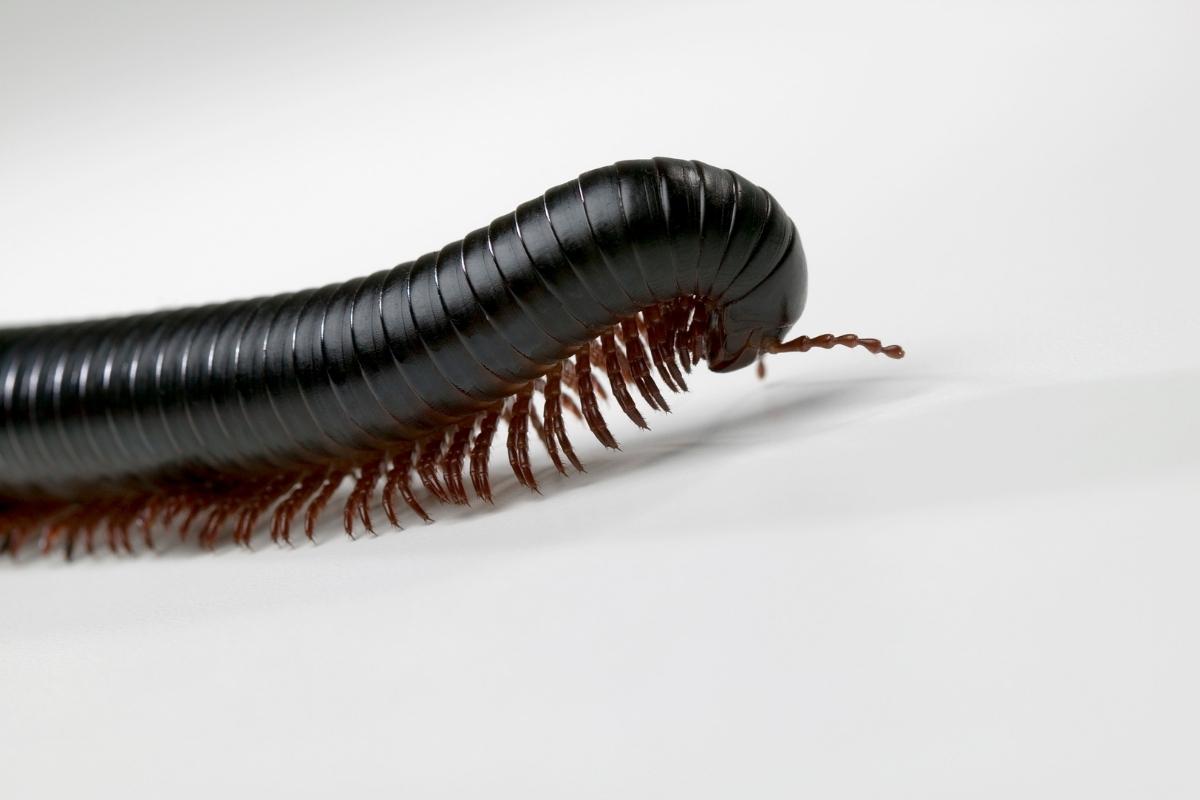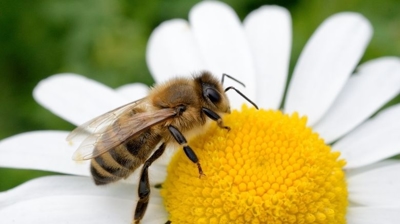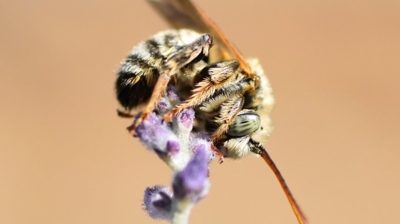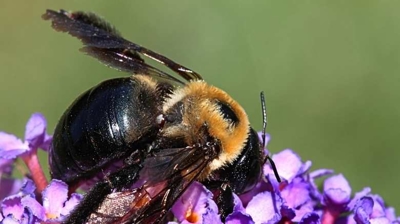
Millipede Control Services

Are Millipedes Harmful?
Millipedes are generally not considered harmful to humans, pets, or structures, but they can become a nuisance in certain situations. Here are some ways millipedes might be problematic:
- Infestations in Homes – While millipedes prefer damp, outdoor environments, they may invade homes in large numbers, especially during wet or cold weather. They do not cause structural damage but can be an annoyance when they gather in basements, crawl spaces, or bathrooms.
- Crop and Garden Damage – Some species of millipedes feed on plant roots, seedlings, and decaying organic matter. In large numbers, they can damage young plants, particularly in moist gardens, greenhouses, or agricultural fields.
- Foul Odor and Defensive Secretions – When threatened, many millipede species release a defensive fluid containing chemicals like hydrogen cyanide (in small, non-lethal amounts), benzoquinones, or other irritating substances. This secretion can stain surfaces, cause skin irritation, and may be harmful to pets if ingested.
- Allergic Reactions or Skin Irritation – Some people may experience mild allergic reactions or skin irritation if they come into contact with millipede secretions. Washing hands thoroughly after handling them is recommended.
- Attraction of Other Pests – Millipedes are prey for various predators, including certain insects, spiders, and rodents. Large millipede populations around a home or business might attract unwanted pests seeking food.
Learn more: Do Millipedes Bite?
Learn more: Are Millipedes Poisonous?
Millipede Control
Our professional millipede control is worthwhile because these pests can quickly become a nuisance and are often more difficult to manage than they appear. While millipedes are not destructive in the same way as termites or rodents, they can invade homes and businesses in large numbers, creating sanitation issues, damaging plants, and leaving behind an unpleasant odor when crushed. Here are some of the reasons to consider our professional millipede control:
- Elimination of Entry Points and Breeding Grounds: Millipedes thrive in damp, dark environments such as basements, crawl spaces, mulch beds, and foundation cracks. Our professionals don’t just kill the millipedes you see; they identify and treat the moisture issues and access points that are fueling the infestation, preventing ongoing problems.
- Effective, Targeted Treatments: Over-the-counter sprays and DIY solutions often provide only temporary relief. Our professionals use specialized products and application techniques that are safe, effective, and designed to target both adult millipedes and the conditions that attract them.
- Protection Against Large-Scale Infestations: Millipedes can invade in overwhelming numbers, especially after heavy rains or in the fall when they migrate indoors seeking warmth. Our professional control plan stops infestations before they escalate, sparing you the stress and cleanup.
- Prevention of Property and Plant Damage: Millipedes feed on decaying organic matter but will also damage seedlings, houseplants, and garden vegetation. With our professional control, you not only remove the immediate infestation but also safeguard your landscaping and indoor plants.
- Long-Term Solutions and Monitoring: We don't just address the problem once; we set up a management plan that includes recurring inspections, treatments, and recommendations to keep your property millipede-free year-round.
- Safe, Hassle-Free Service: Millipede infestations often require treatments in hard-to-reach or damp areas. Our professional technicians have the right protective equipment, tools, and expertise to handle these pests safely and efficiently, without you having to expose yourself or your family to unnecessary chemicals.
Our professional millipede control gives you more than a quick fix—it addresses the root causes of infestations, prevents recurring issues, and protects both your property and peace of mind.
Learn more: How To Get Rid Of Millipedes
What Do Millipedes Look Like?
Millipedes are easily recognizable by their distinct physical characteristics. Here is a detailed description of what millipedes typically look like:
- Body: Millipedes have elongated, cylindrical bodies that are segmented. These segments are often referred to as "rings" or "body segments."
- Color: Millipede colors vary widely depending on the species, but they are often dark brown or black. Some species have striking patterns or brighter colors, while others may appear more drab.
- Size: Millipedes come in various sizes, ranging from a few millimeters to several inches in length. The number of body segments and legs increases with the millipede's size, but they do not have anywhere close to a thousand legs, despite their name.
- Legs: One of the most distinguishing features of millipedes is their numerous legs. Each body segment typically bears two pairs of legs. While it may seem like they have many legs, their actual leg count varies by species, with common counts ranging from 30 to 400 legs or more.
- Antennae: Millipedes have a pair of short antennae located near their head, which are used for sensory perception.
- Head: The head of a millipede is typically small and may be somewhat concealed by the first body segment. They have mouthparts designed for feeding on decaying plant material.
- Defense Mechanisms: Some millipede species have specialized defensive structures. When threatened, they may coil their body into a spiral shape, presenting a tough, armored exterior. Additionally, many millipedes secrete toxic or irritating chemicals through openings on the sides of their body segments as a defense mechanism.
Millipedes have elongated, segmented bodies with numerous legs, a pair of antennae, and a small head. Their coloration, size, and specific features can vary widely depending on the species, but they share these fundamental characteristics that make them distinct from other arthropods like centipedes.
Learn more: Millipedes vs Centipedes
Where Are Millipedes Found?
Millipedes are found in various terrestrial habitats worldwide, but they tend to prefer specific environments that provide the necessary conditions for their survival. Here is a detailed description of where you might commonly find millipedes:
- Forest Floors: Millipedes are often encountered in forested areas, particularly on the forest floor. They thrive in environments with a rich layer of leaf litter and decaying plant material, which provides them with ample food and moisture.
- Damp and Moist Locations: Millipedes are moisture-loving creatures. You are more likely to find them in damp and moist environments, such as under logs, rocks, and fallen leaves. They require high humidity to prevent desiccation (drying out).
- Gardens and Compost Piles: Millipedes are also commonly found in gardens and compost piles. These areas offer a steady supply of decaying organic matter, making them attractive habitats for millipedes.
- Decaying Wood: Millipedes feed on rotting wood and can often be found in and around decaying logs and tree stumps. Some species are specifically adapted to life in decaying wood.
- Caves and Underground Burrows: Certain millipede species have adapted to subterranean life and can be found in caves and underground burrows. These millipedes may have specialized features to help them navigate in the dark.
- Mild and Temperate Climates: Millipedes are more commonly found in regions with mild to temperate climates, but they can also be found in tropical and subtropical areas. Their distribution varies depending on the species.
- Urban and Residential Areas: Millipedes may occasionally venture into urban and residential areas, especially during periods of heavy rain or drought when they are seeking moisture. They may enter homes in search of suitable conditions, so at times they may be considered household pests.
- High-Elevation Habitats: Some millipede species inhabit high-elevation areas, such as mountainous regions. These species have adapted to colder and more extreme conditions.
While millipedes are generally harmless to humans and can be beneficial for ecosystems by aiding in decomposition, some species produce defensive secretions that may cause skin irritation or allergic reactions in sensitive individuals. Therefore, it's advisable to handle millipedes with care and avoid direct contact with their secretions if you come across them in the wild.
Millipede Diet
Millipedes are primarily detritivores, which means they primarily feed on decaying plant material and organic matter. Here is a comprehensive overview of what millipedes eat:
- Decaying Plant Material: Millipedes are highly specialized in breaking down dead and decaying plant material. They feed on fallen leaves, rotting wood, decomposing logs, and other forms of decaying vegetation. Their diet includes both cellulose and lignin, which are components of plant cell walls that many other animals cannot digest.
- Fungi: In addition to plant material, millipedes may consume fungi that grow on decaying organic matter. Fungi provide a supplemental food source for them
- Mosses and Algae: Some millipede species may also graze on small mosses and algae, particularly those found in damp environments.
- Detritus and Organic Debris: Millipedes help break down a wide range of organic debris found on the forest floor or in compost piles. This can include dead insects, animal droppings, and other organic matter.
- Roots and Seedlings (Rarely): While millipedes are primarily detritivores, some species may occasionally feed on living plant material such as plant roots or seedlings. This behavior is less common and tends to involve only a small subset of millipede species.
Millipedes play a critical role in ecosystems by contributing to nutrient cycling. They break down complex organic materials into simpler forms, which are then returned to the soil as nutrients, enriching the ecosystem. However, some millipede species have specialized defensive glands that produce toxic or irritating chemicals. These chemicals serve as a defense mechanism against predators and can deter animals from feeding on them. In some cases, these secretions may cause skin irritation in humans, so it's essential to handle millipedes with care when encountering them in the wild.
Learn more: What Do Millipedes Eat?
Millipede Life Cycle
The life cycle of millipedes, like that of many other arthropods, involves several distinct stages of development. Here is an overview of the typical life cycle of millipedes:
- Egg Stage: The life cycle of a millipede begins with the laying of eggs by adult females. Millipedes lay their eggs in underground burrows, in the soil, or in decaying organic matter. The number of eggs laid can vary widely depending on the species, with some species producing only a few eggs and others producing many.
- Nymph Stage: After a period of incubation, the eggs hatch, giving rise to young millipedes known as nymphs. Nymphs are smaller versions of adult millipedes and typically have fewer body segments and legs. They go through a series of molts as they grow, gradually increasing in size and developing more segments and legs with each molt.
- Juvenile Stage: As nymphs continue to grow and molt, they enter the juvenile stage. Juvenile millipedes resemble smaller versions of the adults. The number of molts and the time it takes to reach maturity can vary depending on the species and environmental conditions. It may take several months to several years.
- Adult Stage: Once the millipede reaches maturity, it becomes an adult. Adult millipedes are sexually mature and capable of reproducing. They have their full complement of body segments and legs, which varies by species but can range from 30 to over 400 pairs of legs.
- Reproduction: Adult millipedes reproduce sexually. Males deposit sperm packets, which are then picked up by receptive females during a courtship ritual. After mating, females lay eggs, typically in underground burrows or suitable locations in the soil or organic matter.
- Lifespan: The lifespan of an individual millipede varies depending on the species and environmental conditions. Some millipedes may live for only a few years, while others can have longer lifespans.
Millipedes exhibit a variety of life history strategies, and the details of their life cycle can vary between species. Additionally, environmental factors, such as temperature and moisture levels, can influence the duration of each stage and overall life cycle. Despite these variations, millipedes generally follow this pattern of egg, nymph, juvenile, adult, and reproductive stages as part of their life cycle.

Hear From Our Happy Customers
-
"Very Knowledgeable"
The tech that arrived was courteous, professional, and very knowledgeable. He was Great.
- Uerial I. -
"Fantastic & Patient"
Jarvis was fantastic and patient. He answered my questions with an in-depth explanation and addressed all of my areas of concern. Would love for him to be my assigned tech going forward. Well done!
- Yonnette M. -
"Exceeds Expectations"
I can’t say enough positive things about this company... The tech that came out, Jarvis went above and beyond my expectations. Thank you guys, I will continue using your services.
- Jake M. -
"Great Communication"
Tech was on time, communication was great, and he accommodated my needs.
- Alonzo W. -
"Professional & Considerate"
I’m pleased with Miche services. Jarvis came today. Professional and considerate. Thank you!
- Judy B. -
"Wonderful Service"
Wonderful service. Jarvis is great. Took care of everything I needed. Thank you!
- Henry P.



